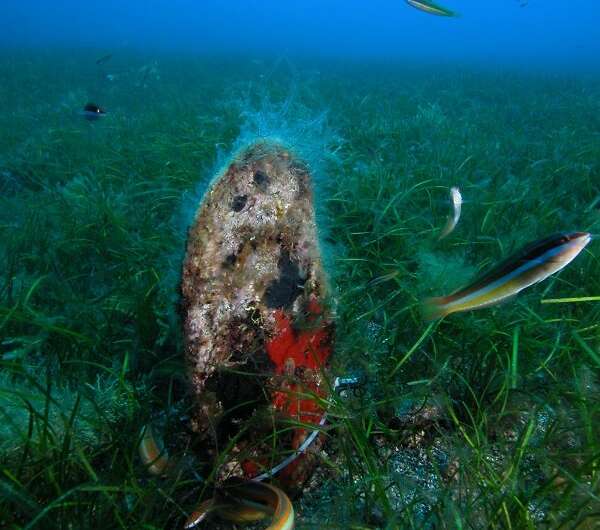Protecting the marine areas that distribute larvae will be decisive for the future of the species in the Mediterranean. Credit: Diego Kersting, UB-IRBio
Fan mussel populations—the biggest bivalve mussel in the Mediterranean—are endangered due to the severe parasitosis caused by the protozoan Haplospridium pinnae since 2016. Now, a study published in the journal Frontiers in Marine Science reveals the fan mussel would express a certain natural ability to recover thanks to the dispersal in the marine environment of larvae from populations which are not affected by the pathogen. These populations would be crucial for the future of the species.
The study is led by the expert Diego Kersting, from the Faculty of Biology and the Biodiversity Research Institute (IRBio) of the University of Barcelona.
A lifesaver for an endangered species
The future of the fan mussel (Pinna nobilis)—one of the largest and long-lived bivalves worldwide—is becoming more and more uncertain. Parasitosis has affected almost all populations of this species in the Mediterranean, "except for some which seem to be free from pathogens and are in environments—specially in coastal lagoons or deltas—which are under certain conditions of salinity, such as the Mar Menor (high salinity) and the Ebro Delta (low salinity). Apart from these particular habitats, most populations of the fan mussel would have disappeared or are endangered species since 2016," says Kersting, first author of the article.
As part of the study, experts monitored for three years the effects of massive mortality in fan mussels during the recruitment process, that is, the introduction of young individuals to the adult population. in the study, experts used larval collectors placed in 38 localities of the western Mediterranean, northern Africa and the Adriatic Sea.
The study shows that massive mortality alters the recruitment process of the fan mussel, which involves a loss of adult population and an obstacle for the recovery of the species. "The recruitment is the main way to recover the species as long as there are recruiters that resist the disease, and unaffected populations that can work as larval exporters," says Kerving.
However, exceptionally, recruitment episodes have also been recorded in areas where fan mussel populations had disappeared due to massive mortality. By using current models and the location of unaffected populations, experts have determined the areas of origin of these larvae, for instance, the Ebro Delta or the coast of Algeria and southern France, which would become a true lifesaver for this species in extreme situations.
"Populations in areas not affected by the parasite are exporting larvae that can travel hundreds of kilometers thanks to ocean currents. Therefore, these populations can play a decisive role in the recovery of the species in the Mediterranean," says Kersting. "In addition, everything suggests that the parasitosis does not seem to affect dramatically larvae or juvenile specimens during the first months of life."
The recovery of the affected populations, if this takes place, could be a very limited process and many years in duration, experts warn. However, the protection of marine areas that can act today as larvae donors should be extreme. "In general, these are highly anthropized areas and are subject to many threats. For this reason, its conservation and protection should be a priority to avoid any type of impact or ecological stress on fan mussel populations, which build the only hope for the recovery of the species," says Kersting.
Science to protect an emblematic species in the Mediterranean
In only a short time, the fan mussel has gone from being considered a vulnerable species to joining the Red List of Threatened Species of the International Union for Conservation of Nature (IUCN). Apart from the study on recruitment as the main process of recovery of populations, the international research effort to save the species also focuses on studying the parasitosis and the causative pathogen, in order to better understand how it works and thus predict the evolution of the infection in the future.
"Today, it has to be yet confirmed whether the virulence of the disease is due solely to the protozoan H. pinnae or whether other microorganisms could also be involved. Despite the efforts of the international groups to collaborate on this issue, it would be necessary to provide more support to current research by the scientific community in order to provide an appropriate response to the critical situation of the fan mussel and prevent the disappearance of an emblematic Mediterranean species," concludes Diego Kersting.
More information: Diego K. Kersting et al. Recruitment Disruption and the Role of Unaffected Populations for Potential Recovery After the Pinna nobilis Mass Mortality Event, Frontiers in Marine Science (2020). DOI: 10.3389/fmars.2020.594378
Provided by University of Barcelona
























